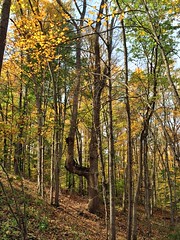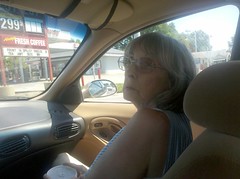Connersville
Connersville is a city in Fayette County, east central Indiana, United States, east by southeast of Indianapolis. The population was 13,481 at the 2010 census. The city is the county seat of and the largest and only incorporated town in Fayette County. The city is in the center of a large rural area of east central Indiana; the nearest significant city is Richmond, to the northeast by road. Connersville is home to the county's only high school. The economy is supported by local manufacturing, retail, and healthcare. Employment and population have been declining since the 1960s and it is among the poorest areas of the state in median household income and other economic measures.
The city is among the oldest cities in Indiana and the former Indiana Territory, having been established in 1813 by its namesake, John Conner.
Economics
The economic base is mostly manufacturing, followed by retail and health care. Little remains of the old industrial base. There are fewer than 600 union employees in the town. The closure of the Visteon plant in 2007, resulting in loss of over 900 jobs, was a chief contributing factor in the town reaching the brink of bankruptcy in March 2014. The largest employers are Stant, Walmart, and Howden Roots (formerly Roots/Dresser), followed by various retail establishments and schools. Wayzata Home Products Connersville, a unit of 6 Square Cabinet Company based in Minnetonka, Minnesota,. began production in March 2014, but has since closed.
The mean house price in 2012 was $67,000, and the median household income $29,000 (versus $47,649 for all of Indiana).
Primarily due to loss of unionized manufacturing jobs and labor, the population of Connersville has been declining since the 1960s. The unemployment rate in Connersville and surrounding Fayette County is among the highest in the state, and has been for most of the last decade and even longer. In 2018, it ranged around 5%. A significant portion of workers in Connersville are employed in Shelbyville, Greensburg, and other outlying towns with better local economies.
The city is the economic center of a micropolitan statistical area of the same name. It is also part of Richmond-Connersville, IN Combined Statistical Area.
History
Connersville is named for settler John Conner, older brother of William Conner, an early Indiana settler and politician. There was also, at least through 1795, Connerstown, a small Shawnee village near Lancaster, Ohio, named for John's father, Richard Conner.
Whitewater Valley and pre-European inhabitants
The Whitewater River Valley running north-south through eastern Indiana and southwestern Ohio was created by the Late Wisconsin Glaciation ending 13,600 years ago. Fayette County was at the southern fringe of the glaciation at that time. The Ice Age was punctuated by several prolonged warm periods during which the glaciers disappeared entirely from the temperate latitudes and a climate similar to today or even warmer prevailed. The flood waters produced resulted in lakes; breaching of the lakes resulted in rivers and streams carving the hills and valleys we see today.
In the Northwest Territory during the latter half of the 18th century, the Miami Indians were dominant in the region, but the Potawatomi and Shawnee had a significant presence. Delaware Indians, displaced from their eastern homelands by European settlement, migrated west and settled along the forks of the Whitewater River. The Whitewater Valley and Ohio River Valley area had also been inhabited earlier by other Native Americans called mound builders for their characteristic large burial mounds still in evidence today.
The geological aspects of the Whitewater River Valley contributed to early settlement after defeat of the Delaware Indians by Gen. Anthony Wayne at Fallen Timbers in 1794, followed on August 3, 1795, by the Treaty of Greenville (Ohio) ceding most of Ohio and a sliver of southeastern Indiana to the United States. The valley, running south and southeasterly from east central Indiana to the Ohio River Valley, provided a convenient conduit for migration through Fort Washington (Cincinnati) from points east, settlements on the Ohio River, and settlers from Kentucky to northern and central Indiana Territory. Squatters engaged in agriculture and trading were occupying federal lands well before land sales in Indiana Territory began in 1801. An Indian trail paralleled the river from the Ohio Valley northward to the forks, then went along the East Fork to Eli Creek, thence taking a northwesterly direction passing through what was later Connersville, and then on to the Delaware villages strung along the White River from north of present-day Indianapolis to modern Muncie.
Conner's Post
John Conner, his brother William, and others arrived in the Whitewater Valley from south central Ohio in 1802, establishing a fur trading post in an unpopulated area near what was later to become Cedar Grove on the Whitewater River (Franklin County) at the very fringe of the European penetration into the wilderness of Indiana. By 1808, as a result of reduction of Indian hunting grounds by treaty, the trading post, known as "Conner's Post", had been relocated north at the Whitewater River junction with an Indian trail between the Ohio River to the southeast and hunting grounds to the north. According to research by J. L. Heineman, the trading post was located in the middle of what is now Eastern Avenue, at the west end of Charles Street. At that time, the region was inhabited by Delaware Indians. In 1809, the Treaty of Fort Wayne was signed, by the terms of which the land locally known as the "Twelve Mile Purchase" was ceded by the Indians to the government. This tract included a strip in width lying west of the 1795 Greenville treaty line that ran from the midpoint of the Indiana/Ohio border southwest to the Ohio River, cutting off a thin wedge of southeastern Indiana. The strip included most of Fayette County except the extreme northern portion (part of the later "New Purchase"). Sales of public land by the United States government in Indiana began in 1801. In that year the Cincinnati, Ohio, Land Office began selling land in a wedge of government land in southeastern Indiana known as the "Gore" (organized as Dearborn County in 1803) which included all of what is today Fayette County. Conner obtained title to his plat in 1811.
First 50 years – through the Civil War
The exodus of the Delaware Indians from Indiana after the War of 1812, completed by June 1813, deprived John Conner of his field for trading. After 1812, Indian resistance to settlement in the Indiana Territory became nearly non-existent, so Conner busied himself with another task.
John Conner laid out the town on the north side of the west fork of the Whitewater River in March 1813, adjacent to the fur trading post. The original plat was for 62 lots bounded by what are today Central Avenue to the west and Water Street to the east, Third Street to the south, and Sixth Street to the north. The first constructions in the town were a saw mill and grist mill north of town utilizing water power, and a general store and distillery in town. The influx of settlers was initially sparse – as late as 1815, there were only four cabins in the town. The boundary lines for Fayette County were established in December 1818, and Connersville was chosen as the county seat.
Conner served briefly as sheriff of the newly organized Fayette County. In 1820, John Conner helped plat the new capital of Indianapolis, and in 1822 relocated his fur trading business to Noblesville, north of Indianapolis. He also served as state senator and representative. He died in Indianapolis in April 1826 and was buried there. No trace remains of his grave.
The first post office in Connersville opened in January, 1818. The first courthouse was started in 1819 and finished in 1822. The first newspaper, the Indiana Statesman, was started in 1824. The first church in the village was Presbyterian, constructed in 1824. A seminary building was constructed in 1828, later razed, and the first regular school building in Connersville was constructed on the site in 1858. The ''Indiana Gazetteer'' in 1833 stated the population of Connersville as 500. The village was incorporated as a town in 1841. Connersville served as an important link on the Whitewater Canal linking the Whitewater River to the Ohio River, opened in 1847. The canal ceased to be used for through traffic in 1849, though limited local commerce continued. The first railroad, the Cincinnati, Hamilton and Indianapolis Railroad, reached Connersville in 1862. It extended from Rushville through Connersville and Oxford to Hamilton, Ohio.
For many years prior to the Civil War, and even for some time after, the main industries of the town were milling, pork packing, and woolen manufacturing.
In 1857, a separate village, East Connersville, was platted on the south bank of the west fork of the Whitewater River, and had its own government. It was annexed by Connersville some time in the 1920s.
Early growth – pre-industrial age
The Roots blower, a type of air turbine, was invented by the Roots brothers in Connersville in the 1850s, patented in 1859, and manufactured in Connersville for over 150 years.
The town of Connersville became a chartered city in June 1869, and William H. Beck was chosen as its first mayor. The first high school opened in 1875. In 1882, James H. Fearis of Connersville started the Bell telephone exchange. The Connersville Electric Light Company commenced operations in August 1890 as the first supplier of electric power in the city. Central Avenue was paved with brick in 1902, and became the first paved street in the city.
Prior to the advent of automotive manufacturing, Connersville for decades was colloquially known as the "furniture and buggy town" because of the dominance of those two industries in the town.
In 1898, Stant was founded in Connersville, and became the world's largest producer of piano tuning…
Looking for places related to Connersville?
Those are other destinations to find places related to Connersville:


















